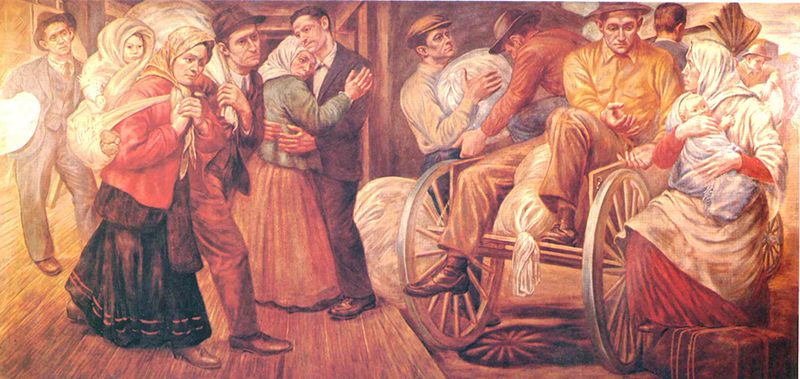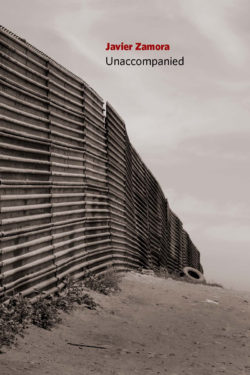Reimagining Immigration

Ellis Island Arrivals, Ellis Island mural detail, 1937. Photo courtesy of The Public Buildings Service, General Services Administration, Washington, DC.
By Stuart Mitchner
Mural painters love walls. In place of a symbolic denial of freedom, a barrier between two countries, they see an immense panorama of possibility, a space free but necessarily and beautifully finite. When muralist Edward Laning (1906-1981) looked at the 100-foot-long wall of the Aliens Dining Hall at Ellis Island, he was pondering his assigned subject, “The Role of the Immigrant in the Industrial Development of America.” He was happy to have the work. It was 1934, he was broke and months behind in his rent for a top-floor loft with skylights on East 17th Street. As he recalls in “Memoirs of a WPA Painter” in American Heritage (October 1970), doing justice to his subject meant “learning how railroads were built and saw mills were operated and coal was mined and steel was manufactured.”
Salvaging the Mural
The Ellis Island mural was very nearly lost due to extensive water damage from a leaky roof, as well as serious neglect and vandalism during the years after the immigration center closed in 1954. Several of the eight original panels had gone missing, presumably due to theft. In 1970, the surviving sections were removed and restored under Laning’s supervision and relocated to the Theodore Roosevelt Federal Courthouse in downtown Brooklyn. A 2013 article posted on bklynr.com (“Breathing Free: A salvaged WPA-era masterpiece … welcomes immigrants once again”) describes a citizenship ceremony presided over by Judge Marilyn Go. Speaking to 267 immigrants from 50 countries including China, the Dominican Republic, Ecuador, India, Liberia, and South Korea, Go mentioned her own family’s journey from China when she was 6 years old. Then she pointed to the murals looming behind the citizens-to-be, “vast images created to welcome immigrants to the country” showing “dozens of figures engaged in the work of building railroads and fueling factories, debarking from ships, and beginning their lives in America.” The judge’s intention was to have the newly arrived citizens imagine themselves “within the full history of immigration.” The article goes on, however, to point out “the gulf of decades, in which the status of the immigrant has gone from boon to burden.”
“Island of Tears”
 In Tyler Anbinder’s City of Dreams: The 400-Year Epic History of Immigrant New York (Houghton Mifflin Harcourt $35), the Ellis Island chapter begins with the “shouts of joy” from immigrants first viewing of the Statue of Liberty on the way to the “terrifying gauntlet of physical and oral examinations” that awaited them at Ellis Island, which Italian immigrants often referred to as l’Isola dell Lagrime,” the “Island of Tears.”
In Tyler Anbinder’s City of Dreams: The 400-Year Epic History of Immigrant New York (Houghton Mifflin Harcourt $35), the Ellis Island chapter begins with the “shouts of joy” from immigrants first viewing of the Statue of Liberty on the way to the “terrifying gauntlet of physical and oral examinations” that awaited them at Ellis Island, which Italian immigrants often referred to as l’Isola dell Lagrime,” the “Island of Tears.”
There’s a hint of recent border issues in the fact that from 1875 to 1917, Congress created “an increasingly long list of conditions that might bar a potential immigrant from entering the United States. Medical problems, political beliefs, even one’s occupation or employment status could cause inspectors to turn an immigrant away.” Anbinder, a journalist who had crossed in steerage with the immigrants, said that arrival at Ellis Island was “the nearest earthly likeness to the final Day of Judgment, when we have to prove our fitness to enter Heaven.”
In a later chapter titled “Renaissance,” the view of Ellis Island as an ordeal gives way to something more in keeping with Judge Go’s upbeat depiction of the Laning murals as welcoming images of inclusion. After describing the postwar decline in immigration that led to the closing of Ellis Island, Anbinder quotes a New York Times editorial stating, “If all the stories of all the people who stopped briefly or for a longer time on Ellis Island could be written down, they would be the human story of perhaps the greatest migration in history.” Not only had Ellis Island’s millions of immigrants made countless contributions to American society, they had become “part of what is now the American temperament — a livelier and richer national personality than could ever have existed without them.”
The jacket copy calls City of Dreams an “inspiring account” of both “famous and forgotten immigrants.” Among the famous and infamous who passed through the barriers are two future mayors of New York City (Abe Beame and Vincent R. Impellitteri), along with Dracula and Tarzan (Bela Lugosi and Johnny Weissmueller), Cary Grant and Bob Hope, composer Irving Berlin, film director Frank Capra, renowned pianists Vladimir Horowitz and Arthur Rubinstein, and Princeton’s most illustrious citizen Albert Einstein, along with mobsters Joseph Bonnano, Joe Adonis, and Lucky Luciano.
Six Little Words
Larry Smith’s Six Words Fresh Off the Boat: Stories of Immigration, Identity, and Coming to America (Kingswell $15.99) includes hundreds of glimpses of the immigration experience, from everyday people, not to mention celebrities like Aziz Ansari, Julianne Moore, Mario Batali, Neil Gaiman, Amanda Palmer, Billy Collins, Junot Diaz, and Dr. Sanjay Gupta. Smith’s idea of seeking six-word life stories originated with the legend of Ernest Hemingway’s six-word story: “For sale, baby shoes, never worn.”
Six Words is prefaced by a note stating that “due to the current political environment,” some names have been changed. Smith explains that the project was conceived before Trump’s election, with the result that “the unsettling political climate for immigrants that he has ushered in has made the discussions that follow from these stories more vital than ever.”
Immigration in Poetry and Prose
 Poet Javier Zamora, the author of Unaccompanied (Copper Canyon Press $16), was 9 years old when he traveled alone 4,000 miles, across multiple borders, from El Salvador to the United States to be reunited with his parents. This poetry debut describes borderland politics, race, and immigration while remembering the birth country that’s been left behind. Zamora graduated from the University of California at Berkeley. He earned an MFA at New York University and was a 2016-2018 Wallace Stegner Fellow at Stanford.
Poet Javier Zamora, the author of Unaccompanied (Copper Canyon Press $16), was 9 years old when he traveled alone 4,000 miles, across multiple borders, from El Salvador to the United States to be reunited with his parents. This poetry debut describes borderland politics, race, and immigration while remembering the birth country that’s been left behind. Zamora graduated from the University of California at Berkeley. He earned an MFA at New York University and was a 2016-2018 Wallace Stegner Fellow at Stanford.
Edwige Danticat’s family memoir, Brother, I’m Dying (Vintage Contemporaries $16), won the 2007 National Book Critics Circle Award. In it, according to Vogue, “Danticat pays moving tribute to the two men who raised her — her uncle, with whom she lived in Haiti until the age of 12, and her father, whom she then joined in America — documenting a disintegrating Port-au-Prince and dubious American immigration policies.”
 A recent novel about immigration is Rutgers graduate Imbolo Mbue’s Behold the Dreamers (Random House paperback $17), which won the 2017 PEN/Faulkner Award for Fiction. The New York Times calls Mbue’s “dissection of the American Dream … savage and compassionate in all the right places.” NPR says the novel depicts a country both blessed and doomed, on top of the world, but always at risk of losing its balance.”
A recent novel about immigration is Rutgers graduate Imbolo Mbue’s Behold the Dreamers (Random House paperback $17), which won the 2017 PEN/Faulkner Award for Fiction. The New York Times calls Mbue’s “dissection of the American Dream … savage and compassionate in all the right places.” NPR says the novel depicts a country both blessed and doomed, on top of the world, but always at risk of losing its balance.”
Wedding of the Rails
Edward Laning was 28 when he began work on the Ellis Island murals. Half a century later, at 71, he painted The Building of the Transcontinental Railroad for the Railroad Museum in Ogden, Utah, on a National Historic site marking the meeting place of the railway joining the nation’s east and west coasts. Originally conceived by the Roosevelt administration as the “Wedding of the Rails,” the vision of laboring immigrants was intended as a complement to the Ellis Island commission. The mural occupies two separate panels, one, the Union Pacific, showing coolie-hatted Chinese laborers at work, the other, Central Pacific, depicting a mostly Irish crew. The project was completed in 1979 and the murals were installed in January 1980. When he died in May of the following year, Laning was at work on a series of murals on American literature for the Periodicals Room of the New York Public Library, the site of the central achievement of his life, The History of the Printed Word, the four immense panels and a ceiling mural, Prometheus, illuminating the McGraw rotunda.

Edward Laning and assistants work on the Ellis Island mural, tasked as “The Role of the Immigrant in the Industrial Development of America.”
otunda.

